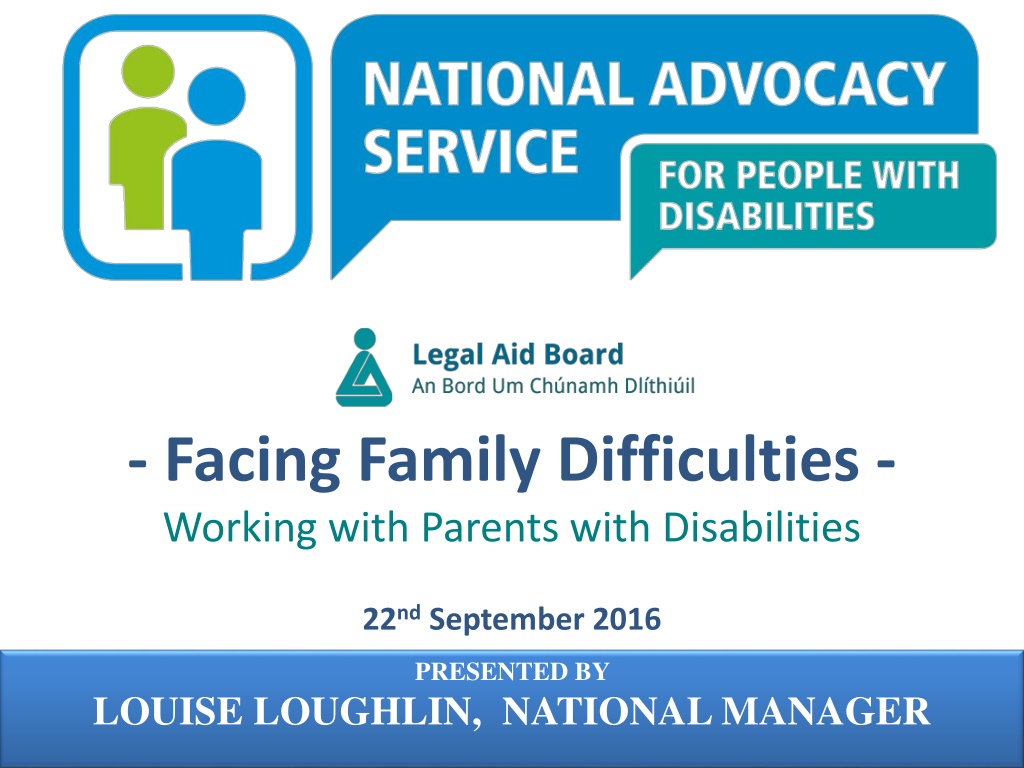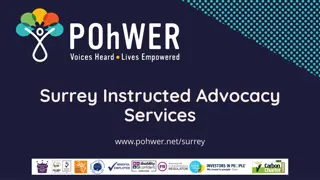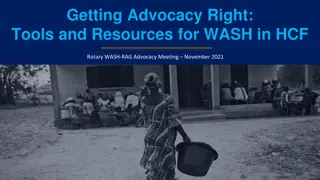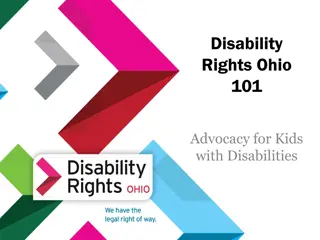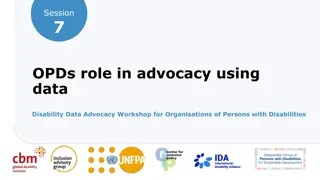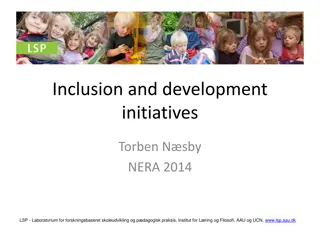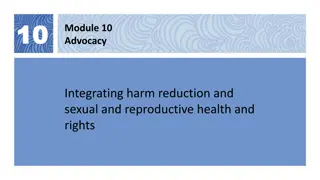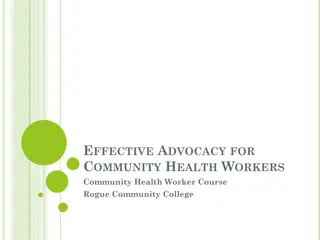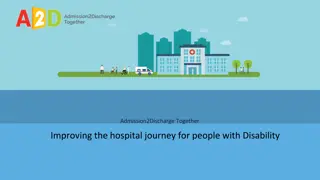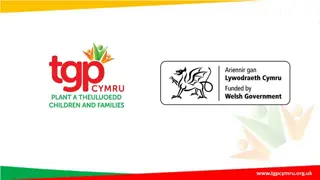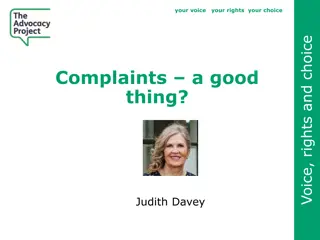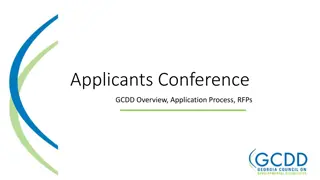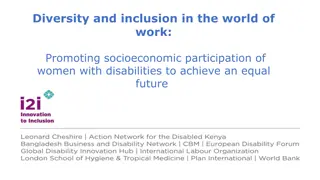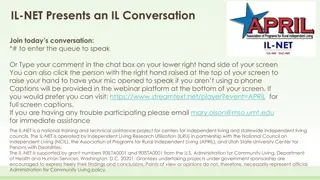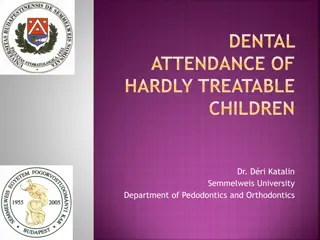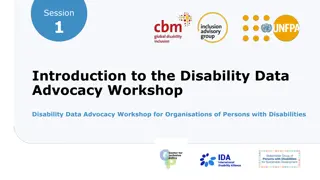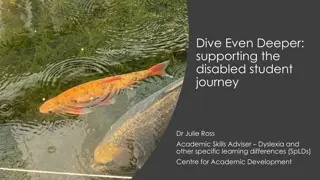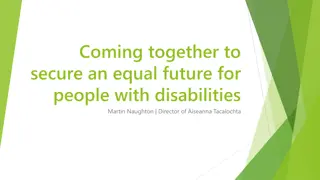National Advocacy Service for People with Disabilities: Empowering Choices and Inclusion
The National Advocacy Service (NAS) for People with Disabilities in Ireland, established in 2011, aims to empower individuals with disabilities, ensuring they have equal opportunities and choices in life. With a statutory function to provide advocacy, NAS focuses on principles such as empowerment, inclusion, autonomy, and citizenship. The service addresses the challenges faced by people with disabilities in communication, decision-making, and rights assertion, emphasizing the importance of professional advocacy. Through NAS, individuals are supported in expressing their views, securing their entitlements, and enhancing their control over their lives.
Download Presentation

Please find below an Image/Link to download the presentation.
The content on the website is provided AS IS for your information and personal use only. It may not be sold, licensed, or shared on other websites without obtaining consent from the author. Download presentation by click this link. If you encounter any issues during the download, it is possible that the publisher has removed the file from their server.
E N D
Presentation Transcript
Site Logo - Facing Family Difficulties - Working with Parents with Disabilities 22nd September 2016 PRESENTED BY LOUISE LOUGHLIN, NATIONAL MANAGER 1
WHAT IS THE NATIONAL ADVOCACY SERVICE FOR PEOPLE WITH DISABILITIES ? Launched in March 2011 Comhairle Act 2000 and The Citizens Information Act 2007 gave CIB a statutory function to provide advocacy to people with disabilities; National Manager and 4 regional teams, 4 regional managers, 7 senior advocates, 5 admins and 28 advocates; Based on the principles of empowerment, inclusion, autonomy and citizenship. 2
DISABILITY IN IRELAND Currently there are 600,000 people who are defined as having a disability in Ireland (CSO, 2012); Probably figure a lot higher (undiagnosed/ misdiagnosed); International research studies highlight the impact of disability on a person s sense of self and how this can have major impacts on their engagement with professionals (Nettleton, 2005; 2013). 3
HOW WE COMMUNICATE Studies show that people with a disability experience greater communication barriers by 66 % (Farrelly, 2012); Professional services need to make a shift to reach out to people with differentcommunication ; 70% of Human Communication is Non-verbal; Often acceptance of communication limitations restricts a person's right to make decisions. http://www.gov.scot/Resource/Doc/210958/0055759.pdf 4
WHY IS THERE A NATIONAL ADVOCACY SERVICE FOR PEOPLE WITH DISABILITIES ? Because sometimes people with disabilities are not listened to or given the chance to make their own choices. People with disabilities are often treated differently from non disabled people. Nearly everyone agrees that we should all be treated the same and have the same chances and choice in life. NAS aims to ensure that people with disabilities have those chances and choices. 5
Why Professional Advocacy ? Everyone should be able to: make choices exercise their rights be independent be part of their community People who have disabilities often experience difficulties in asserting their views and/or securing their rights and entitlements. This can lead to people have limited choices and little control over their lives. Professional Advocacy can help address this. 6
WHO IS NAS FOR ? The main focus of the service are the people in the most vulnerable situations, including those who are; isolated in the community residing in inappropriate accommodation unconnected to services and those with communication differences who may find it difficult to represent themselves. NAS uses Access and Eligibility Criteria to determine when to open a case. 7
LEGAL FRAMEWORK NAS operates in a framework of existing Irish and other law which is outlined below. We use these laws to inform and guide our practice, and as tools for resolution of client issues by way of representation and negotiation. Disability Act 2005 (assessment of need currently for children only); Citizens Information Act 2007 (onus on CIB to support the provision of advocacy for people with disabilities); Assisted Decision Making (Capacity) Act 2015; European Convention of Human Rights Act 2003; UN Convention on the Rights of People with Disabilities (signed by the ROI but not yet ratified) 8
LEGAL FRAMEWORK CONT. We also look to Government policy including:- National Disability Strategy; Vision for Change (2006); Time to move on Congregated Settings (2011); Vfm & Policy Review of Disability Services in Ireland (2012); HIQA Standards; MHC Standards 9
WHEN AN ENQUIRY IS RECEIVED BY NAS Work together to explore the issue & develop advocacy plan in accordance with the persons wishes Assess suitability of service Meet with the person Gather information The role of the advocate is to get to know the person and support them to have their wishes and preferences at the centre of the decision making process. 10
WHEN A REFERRAL IS RECEIVED CONT. In a case where the client is not in a position to articulate their will or preferences the advocate uses 4 internationally recognised approaches to try to ascertain the person s will and preference. The advocate examines the options available, asking questions on the person s behalf and, and examines how the course of action will impact on the person s quality of life. From the person WITNESS OBSERVER PERSON CENTREDNESS Person Centred Plans Policy documents Approaches when working with a person with communication differences Gathering Information ORDINARY LIFE PRINCIPLES Eight Quality of Life Domains RIGHTS BASED APPROACH Significant people in the persons life e.g. family Various professionals 11
WHAT THINGS CAN WE HELP WITH ? Where to live Who to live with What kind of place do I want to live in What to do during the day Working Training Learning Transport How can I get around What to do in the evening Sports Hobbies Socialising Money How much do I have Who makes decisions about my money How can I make decisions myself Quality of life Loneliness Fear of speaking up Equal treatment mainstreaming use services like everyone else Services mental health, physio, social work, housing, county council Medical Why do have to see doctors Why do I take medicines How can I find out more What choice do I have 12
WHAT TYPE OF THINGS DO WE DO ? We might:- Spend time with the person listening to them Find out who is involved in decision making in the person s life; Find out who is in the person s life family and friends and talk to them Find out what the person s financial situation is Meet with the person who can make decisions HSE, social worker, manager, doctor Support the client to find out more about what they want to do What else will the client need to help achieve their goal? We always work with you the person, we might listen to other people, but we always support you in what you want to do. 13
NAS CASE EXAMPLE: A CLIENT WITH AN ABI SEEKS THE ASSISTANCE OF THE NAS TO GET DISCHARGED FROM WARDSHIP The client contacted the advocate about discharge from wardship. The lady had sustained a brain injury following a RTA several years before. The client and advocate developed an advocacy plan. Actions undertaken by the client and advocate: Accompanied client to solicitor Assisted client to explore the option of legal aid Assisted client to liaise with Ward of Court office by email, letter and phone Assisted client to liaise with medical professionals and to document their life story for the independent medical assessor Assisted client to identify appropriate community supports Provided support and encouragement as this process had been under taken in the past Client was discharged from wardship SUPPORTING SELF ADVOCACY ASSIST WITH ACTIONS PROVIDE INFORMATION 14
NAS AND CHILD CARE CASES Represent approximately 12% of current caseload Can be pre litigation at an early stage supporting parents to:- Engage with family support Identify what supports are needed Support the parent at case conferences Prepare for assessments 15
NAS AND CHILD CARE CASES cont Support parent to access legal services Support parent to engage with legal services Support parent at case reviews Support parent at court to follow and understand proceedings Support parent to make access arrangements 16
What NAS does NOT do Explain legal documents in the place of the solicitor/barrister Explain reports eg medical reports in place of the solicitor/barrister Undertake formal capacity assessments Take instructions of behalf of legal professionals 17
ADVOCACY AND THE ADM s8. (2) It shall be presumed that a relevant person paragraph(a) of the definition of relevant person in section 2(1) has capacity in respect of the matter concerned unless the contrary is shown in accordance with the provisions of this Act. who falls within 18
ADVOCACY AND THE ADM NAS works from the premise that all persons who use our service have capacity, but that they may need some support to express their will and preference; It is for us to discern that will and preference and to support the communication of that will and preference to other parties; It can be seen therefore that NAS has already incorporated the s8 principles into practice; 19
ADVOCACY AND THE ADM The implementation of the ADM is likely to be challenging for many organisations and professions including advocacy; The Act has not given citizens a right to advocacy; Although advocacy is recognised in the HIQA standards for residential services for people with disabilities, and the Mental Health Commission Code of Practice; 20
ADVOCACY AND THE ADM Decision making assistance agreement Co-decision making agreement Court appointed decision maker Expert reports Capacity assessments There is a role for advocacy in all of these areas for people with disabilities in the context of supporting individuals to have their voice heard 21
COMMUNICATION cont Mr. Justice Peter Jackson in Lancashire County Council v M [2016] EWFC http://www.jasonhadden.co.uk/journal/plai n-english-a-judges-journey-into-the- unknown 23
COMMUNICATION cont The judgment is clear, concise and very easy to read. These were care proceedings concerning four children, in which there was a concern that the father of the youngest two children might take them to Syria. The judgment has been kept as short as possible so that the mother and her older children could follow it. What is perhaps so surprising is that this use of plain English is not more common. Particularly when the Plain English Campaign was set up almost 40 years ago with a campaign against gobbledygook, jargon and misleading public information. Certainly no place for legalese. Some might even suggest that a plain English campaign is completely at odds with everything that lawyers stand for. But when many of us now only communicate in 140 characters or less perhaps it is finally time for lawyers to recognise and even embrace this the new world. This type of judgment is long overdue. I appreciate that there is a balance to be struck between setting out the legal test, the analysis and indeed the basis for the judgment; but in care cases there also needs to be recognition of the parties involved and their understanding. Decisions made in care proceedings are life changing; for both the adults and the children. I have often sat with clients who comprehend the odd word here and there, in dare I say, somewhat long winded judgments: listening patiently and desperately simply to know if their children are coming home or not. 24
HOW CAN ADVOCACY WORK WITH OTHER PROFESSIONS ? If we all engage in the cultural shift we may move towards:- Changing how we think about people who need support with decision making; Recognition of the right of individual to make their own decisions; Change how we take instructions; Challenge our own assumptions about capacity. 25
